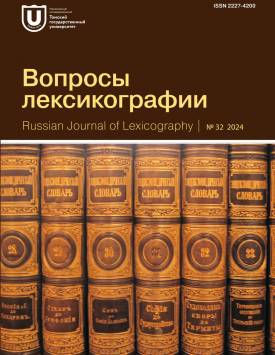A new large Serbian-Russian dictionary (а general conception and problems of lexicographic description)
At Moscow State University, the team of authors is working on a new large Serbian-Russian dictionary (SRD) based on the descriptive dictionary of the Serbian language (2018). Currently the first five letters of the Serbian alphabet have been prepared. The dictionary is aimed at the Russian-speaking user. Compiling the SRD, the vocabulary of the descriptive dictionary is edited and updated. In this case, the authors take into account whether the word belongs to the Serbian or Russian national cognitive base, word-formation and semantic adaptation of borrowings, motivational, semantic and expressive potential of the Serbian word, etc. The dictionary is compiled in the Microsoft Word editor, but at the same time the authors work on the transferring of the already prepared materials onto the OnLex electronic lexicographic platform, which will significantly expand the functionality of the new dictionary. The design of the dictionary entry is based on the entry in the Serbian descriptive dictionary. When transforming an original descriptive entry into an SRD one, many difficulties may arise because of differences in the traditions of grammatical description or definition of collocations, phraseological units, metaphors, etc. However, the main problem that arises is the correlation of the semantics of the original Serbian word with the semantics of the Russian word. Within one meaning, the problem is connected with the selection of equivalents, and within the polysemantic structure, in the adequate representation of this structure in a bilingual dictionary and its correlation with Russian equivalents. A great difficulty for lexicographic description is the functional and stylistic inconsistencies of equivalents. When displaying the structure of a polysemantic Serbian word in the dictionary, it is important to present the entire set of meanings of the original Serbian word. Working on the fragmentation of a polysemantic structure, the authors focus, among other things, on Russian equivalents and try to separate meanings that are characterized by different synonymous series of Russian equivalents. When it is possible, they take into account the achievements of lexical typology. The characteristic differences between Serbian and Russian vocabulary should become the subject of a systematic description in the future. The authors’ work on the dictionary made it possible to identify a number of problems important not only for comparative, but also for Serbian lexicology. One of them is the status in the Serbian literary language of words predominantly used in the west of the Serbian linguistic territory. The authors declare no conflicts of interests.
Keywords
bilingual lexicography, Serbian language, Russian language, comparative lexicologyAuthors
| Name | Organization | |
| Dragićević Rajna | University of Belgrade | rajna.dragicevic@fil.bg.ac.rs |
| Korolkova Maria D. | Institute for Linguistic Studies, Russian Academy of Sciences | skifane@gmail.com |
| Ryzhova Daria А. | National Research University Higher School of Economics | daria.ryzhova@mail.ru |
| Shapich Yulia L. | Center for Russian Science and Culture “Russian House ” | julija.sapic@gmail.com |
| Yakushkina Ekaterina I. | Lomonosov Moscow State University | jkatia@yandex.ru |
References

A new large Serbian-Russian dictionary (а general conception and problems of lexicographic description) | Voprosy leksikografii – Russian Journal of Lexicography. 2024. № 32. DOI: 10.17223/22274200/32/3
